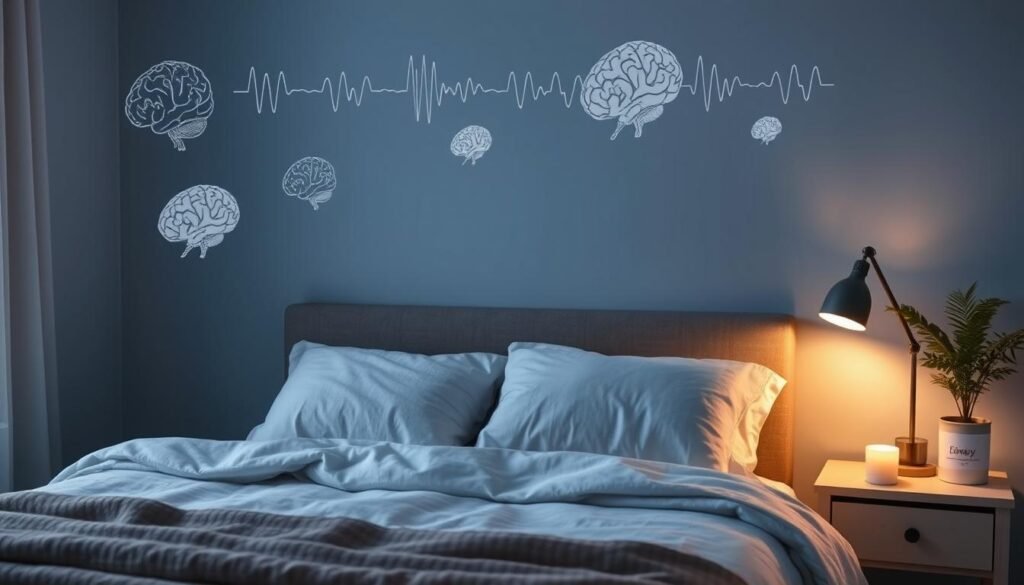Did you know that around 6–10% of people have chronic insomnia? It’s a big problem that messes with sleep and everyday life. Luckily, there’s a strong solution: Cognitive Behavioral Therapy for Insomnia (CBT-I). This isn’t like regular sleep meds that can have side effects and only work for a little while.
CBT-I uses a step-by-step method to change bad thoughts and habits about sleep. Check out the benefits of CBT-I for managing insomnia for a long time. It teaches useful skills that last even after treatment ends. After six to eight sessions, people usually start sleeping better and feeling more upbeat in their day-to-day lives.
Key Takeaways
- Chronic insomnia affects 6–10% of the population.
- CBT-I involves 6 to 8 sessions lasting 30 to 90 minutes each.
- Sleep Restriction Therapy (SRT) and Stimulus Control Therapy (SCT) are key components of CBT-I.
- CBT-I promotes realistic sleep expectations through Cognitive Therapy (CT).
- About 33% to 50% of adults report ongoing sleep difficulties.
- CBT-I provides long-lasting improvements in sleep quality without medication side effects.
Understanding Insomnia and its Challenges
Insomnia affects many adults, causing trouble with falling asleep, staying asleep, or waking up early. About 30% to 50% of adults experience sleep issues, while 7% to 18% are diagnosed with insomnia. It leads to daytime problems and distress.
Many factors cause insomnia, including mental health issues, lifestyle, and environment. It’s vital to understand these factors to tackle insomnia. Those suffering from it face a cycle of worry and negativity about sleep.
Dealing with sleep disorders requires multiple strategies. A key method is the psychological insomnia approach. It uses Cognitive Behavioral Therapy for Insomnia (CBT-I). CBT-I helps by changing thoughts and behaviors around sleep, improving sleep and well-being.
Bad habits like irregular sleep times, too much screen use before bed, and lots of caffeine affect sleep. Managing these habits is crucial for better sleep. For tips on habits related to insomnia, visit this helpful resource.
Understanding insomnia as a whole allows for better management strategies. Approaching sleep disorders needs a mix of psychological and behavioral changes.
The Science Behind Cognitive Behavioral Therapy for Insomnia
Cognitive Behavioral Therapy for Insomnia (CBT-I) is a strong, evidence-based way to fight sleep disorders. Each year, about 30 to 40% of U.S. adults have trouble sleeping. Women and older adults are more often affected. CBT-I helps change negative thoughts and bad habits that stop good sleep.
It helps patients understand and fix wrong ideas about sleep. Studies show CBT-I works as well as sleep drugs, but without the downsides. Drug treatments can cause side effects and dependency. CBT-I avoids these problems and helps people sleep better for a long time.

The treatment usually takes six to eight weeks. It’s one of the best non-drug ways to get better sleep over the long term. People using CBT-I find their sleep improves even after treatment ends. This therapy doesn’t just help with insomnia. It also lessens depression symptoms.
During CBT-I, patients work on five main areas to improve their sleep. These are chosen based on the person’s specific needs. To learn more about CBT-I, its research, and how it’s used, check out articles here.
Benefits of CBT-I for Long-Term Management of Insomnia
Cognitive Behavioral Therapy for Insomnia (CBT-I) helps people with chronic insomnia. It improves sleep and creates healthy sleep habits. CBT-I deals with the root causes of sleep problems.
Improvement in Sleep Quality
CBT-I significantly improves how well you sleep. Around 70% to 80% of patients see better sleep patterns. They enjoy deeper, more refreshing sleep and feel more alert during the day.
By switching from poor to good sleep, CBT-I makes a big difference.
Reduction in Sleep Latency
CBT-I can reduce the time it takes to fall asleep by about 19 minutes. This is a considerable improvement for many. Techniques like sleep restriction and stimulus control are key. They help people fall asleep faster and build good sleep habits.
Long-Lasting Results Beyond Treatment
The impact of CBT-I goes on even after treatment stops. It’s effective for managing insomnia in the long term. People keep sleeping well up to two years post-treatment. This makes CBT-I a better option than sleep meds. It’s the first choice for treating insomnia.

How CBT-I Differs from Traditional Sleep Medications
Up to 30% of people suffer from chronic insomnia. They need treatments that really work. Traditional sleep meds can help you fall asleep quicker. But, they come with big downsides. Effects like daytime drowsiness, feeling foggy, and addiction risks are common. These risks often outweigh the short-term benefits of these meds.
Cognitive Behavioral Therapy for Insomnia (CBT-I) is different. It’s a top choice for treating sleep troubles without drugs. CBT-I gets to the heart of insomnia issues. It teaches habits that promote good sleep. This leads to better sleep over time, without the downsides of meds.
Studies show CBT-I is really effective. It can improve sleep for about 90% of people. Those in therapy go through 4 to 8 sessions. They learn how to deal with their sleep challenges in their own way. This makes CBT-I a lasting solution for sleep issues.
CBT-I helps people rely less on sleep meds. It teaches them to tackle the real reasons behind their insomnia. Unlike meds that only give quick fixes, CBT-I encourages habits for better sleep in the long run.
Components of CBT-I: Techniques That Promote Better Sleep
Cognitive Behavioral Therapy for Insomnia (CBT-I) uses key techniques to improve sleep. It tackles the main causes of insomnia. These methods include working on thought patterns, changing behaviors, and learning to relax. Each plays a big role in fighting sleep issues from both the mind and behavioral sides.
Cognitive Restructuring
Cognitive restructuring helps people fight negative sleep thoughts. It teaches replacing fears about not sleeping with positive views. This shift leads to a calmer mindset at bedtime, helping create a better sleep setting.
Behavioral Interventions
Behavioral changes are core to CBT-I. Practices like limiting bed time boost sleep desire. Controlling what the bed is used for breaks bad sleep links. These steps play a big part in overcoming insomnia, making the therapy more effective.
Relaxation Techniques
Relaxing methods are crucial for lessening stress and getting ready for sleep. Techniques like tensing and relaxing muscles and meditation help with stress and calming down. Using these methods makes falling and staying asleep easier.

Evidence Supporting CBT-I Efficacy
Many studies show Cognitive Behavioral Therapy for Insomnia (CBT-I) works well. It’s a proven method for helping with insomnia. CBT-I improves sleep quality and makes overall sleep patterns better over time.
Research Findings on Sleep Efficiency
In-person CBT-I can match the effectiveness of sleep meds for short-term use. Over the long run, it’s even better, especially after three months. People using CBT-I usually cut down the time it takes to fall asleep and the time they’re awake at night by half. They see a 50% drop in their sleep problems, making CBT-I a top choice for treating insomnia.
Longitudinal Studies on Sleep Improvements
Studies show people who have at least four CBT-I sessions keep getting better. They sleep about 50 minutes more each night, proving CBT-I helps for a long time. About 70% to 80% feel better quickly, and 50% to 60% are doing great 6 to 12 months later. These results show CBT-I is a solid, long-term fix for insomnia.
The Role of Sleep Hygiene in CBT-I
Sleep hygiene is crucial for better sleep and boosting Cognitive Behavioral Therapy for Insomnia (CBT-I). It involves changes to daily habits and where you sleep. This helps manage insomnia well over time.
- Setting a consistent bedtime and wake-up time
- Avoiding naps during the day
- Formulating a calming pre-sleep routine
- Ensuring the sleep environment is cool, dark, and quiet
- Avoiding stimulating activities before bedtime, such as using electronics or engaging in vigorous exercise
Relaxation and stress management are key for better sleep. You can try:
- Practicing deep breathing exercises or meditation
- Implementing progressive muscle relaxation routines
- Utilizing stress-reduction strategies, such as journaling or mindfulness
Good sleep hygiene is very important for those with insomnia. Insomnia makes falling and staying asleep hard. Bad sleep can harm your health, hurt cognitive function, and raise the risk of diseases. Adding good sleep habits to CBT-I helps fight insomnia. For more info on CBT-I and sleep, click here.
Accessibility and Finding a Qualified CBT-I Provider
Finding help for insomnia isn’t easy, especially with so few specialists in the US. It’s important to find qualified CBT-I practitioners. Knowing this can lead people to the right support for their sleep issues.
Identification of Qualified Practitioners
Looking for a good CBT-I provider takes effort. It’s essential to choose someone certified by groups like the American Board of Sleep Medicine. Insomnia affects about a quarter of people. It costs more than $100 billion a year. This makes finding effective treatments like CBT-I very important.
Despite CBT-I working well, there are only 752 specialists worldwide. Most are in the USA. Knowing where these experts are can help find the right treatment.
Utilizing Online Resources for Assistance
The web is full of resources for finding CBT-I help. There are directories of certified sleep centers and experts. These sites also explain CBT-I methods. This can help people manage their sleep better on their own. Using these online tools can improve sleep and mental health.
| Criteria | Importance | Resources |
|---|---|---|
| Certification | Ensures expertise in CBT-I | American Board of Sleep Medicine |
| Experience | Higher success rates with trained therapists | Society of Behavioral Sleep Medicine |
| Reviews | Feedback can guide selection | Online directories |
| Accessibility | Ease of setting appointments | Local clinician maps |
Conclusion
Cognitive Behavioral Therapy for Insomnia (CBT-I) is a top non-medication way to handle long-term sleep issues. It’s vital for the 20% of American adults who struggle with insomnia. This therapy targets the mind and behavior patterns that block good sleep, avoiding drug reliance and its side effects.
CBT-I improves sleep quality, makes falling asleep easier, and helps create lasting sleep habits. It helps people take back their nights and uplift their lives. It’s proven to ease insomnia and boost life by reducing anxiety and depression too.
More people are learning how effective and reachable CBT-I is, thanks to online therapy. This digital shift makes it easier for people everywhere, especially in less serviced areas. Now, more folks can use CBT-I to better handle insomnia long-term.